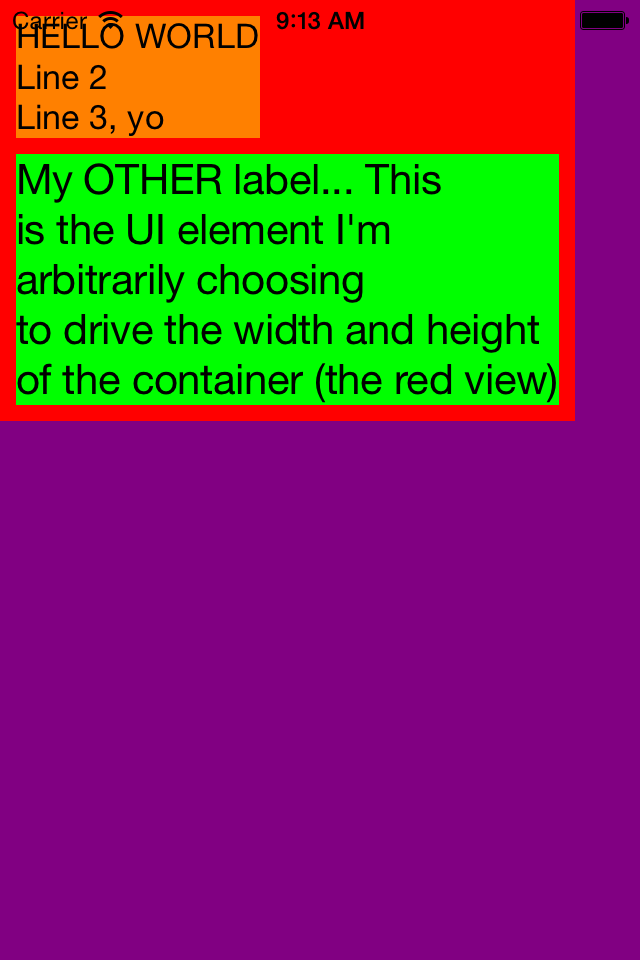еҰӮдҪ•и°ғж•ҙsuperviewзҡ„еӨ§е°Ҹд»ҘйҖӮеә”autolayoutзҡ„жүҖжңүеӯҗи§Ҷеӣҫпјҹ
жҲ‘еҜ№иҮӘеҠЁеёғеұҖзҡ„зҗҶи§ЈжҳҜе®ғйҮҮз”Ёи¶…и§Ҷеӣҫзҡ„еӨ§е°ҸпјҢ并д»ҘзәҰжқҹе’ҢеҶ…еңЁеӨ§е°ҸдёәеҹәзЎҖи®Ўз®—еӯҗи§Ҷеӣҫзҡ„дҪҚзҪ®гҖӮ
жңүжІЎжңүеҠһжі•жүӯиҪ¬иҝҷдёӘиҝҮзЁӢпјҹжҲ‘жғіеңЁзәҰжқҹе’ҢеҶ…еңЁеӨ§е°Ҹзҡ„еҹәзЎҖдёҠи°ғж•ҙsuperviewзҡ„еӨ§е°ҸгҖӮе®һзҺ°иҝҷдёҖзӣ®ж Үзҡ„жңҖз®ҖеҚ•ж–№жі•жҳҜд»Җд№Ҳпјҹ
жҲ‘жңүеңЁXcodeдёӯи®ҫи®Ўзҡ„и§ҶеӣҫпјҢжҲ‘е°Ҷе…¶з”ЁдҪңUITableViewзҡ„ж ҮйўҳгҖӮиҜҘи§ҶеӣҫеҢ…жӢ¬ж Үзӯҫе’ҢжҢүй’®гҖӮж Үзӯҫзҡ„еӨ§е°Ҹеӣ ж•°жҚ®иҖҢејӮгҖӮж №жҚ®зәҰжқҹжқЎд»¶пјҢж ҮзӯҫжҲҗеҠҹжҢүдёӢжҢүй’®пјҢжҲ–иҖ…еҰӮжһңжҢүй’®е’Ңи¶…и§Ҷеӣҫеә•йғЁд№Ӣй—ҙеӯҳеңЁзәҰжқҹпјҢеҲҷж Үзӯҫе°Ҷиў«еҺӢзј©гҖӮ
жҲ‘еҸ‘зҺ°дәҶдёҖдәӣзұ»дјјзҡ„й—®йўҳпјҢдҪҶ他们没жңүеҫҲеҘҪзҡ„зӯ”жЎҲгҖӮ
4 дёӘзӯ”жЎҲ:
зӯ”жЎҲ 0 :(еҫ—еҲҶпјҡ148)
иҰҒдҪҝз”Ёзҡ„жӯЈзЎ®APIжҳҜUIView systemLayoutSizeFittingSize:пјҢйҖҡиҝҮUILayoutFittingCompressedSizeжҲ–UILayoutFittingExpandedSizeгҖӮ
еҜ№дәҺдҪҝз”ЁиҮӘеҠЁеёғеұҖзҡ„жҷ®йҖҡUIViewпјҢеҸӘиҰҒжӮЁзҡ„зәҰжқҹжӯЈзЎ®пјҢиҝҷеә”иҜҘеҸҜд»ҘжӯЈеёёе·ҘдҪңгҖӮеҰӮжһңжӮЁжғіеңЁUITableViewCellдёҠдҪҝз”Ёе®ғпјҲдҫӢеҰӮзЎ®е®ҡиЎҢй«ҳпјүпјҢйӮЈд№ҲжӮЁеә”иҜҘй’ҲеҜ№жӮЁзҡ„еҚ•е…ғж јcontentViewи°ғз”Ёе®ғ并иҺ·еҸ–й«ҳеәҰгҖӮ
еҰӮжһңжӮЁзҡ„и§ҶеӣҫдёӯжңүдёҖдёӘжҲ–еӨҡдёӘUILabelжҳҜеӨҡиЎҢзҡ„пјҢеҲҷеӯҳеңЁиҝӣдёҖжӯҘзҡ„иҖғиҷ‘еӣ зҙ гҖӮеҜ№дәҺиҝҷдәӣпјҢжҲ‘们еҝ…йЎ»жӯЈзЎ®и®ҫзҪ®preferredMaxLayoutWidthеұһжҖ§пјҢд»Ҙдҫҝж ҮзӯҫжҸҗдҫӣжӯЈзЎ®зҡ„intrinsicContentSizeпјҢиҝҷе°ҶеңЁsystemLayoutSizeFittingSize'sи®Ўз®—дёӯдҪҝз”ЁгҖӮ
зј–иҫ‘пјҡж №жҚ®иҰҒжұӮпјҢдёәиЎЁж ји§ҶеӣҫеҚ•е…ғж јж·»еҠ й«ҳеәҰи®Ўз®—зӨәдҫӢ
дҪҝз”ЁautolayoutиҝӣиЎҢиЎЁж јеҚ•е…ғж јй«ҳеәҰ计算并дёҚжҳҜйқһеёёжңүж•ҲпјҢдҪҶе®ғзЎ®е®һеҫҲж–№дҫҝпјҢзү№еҲ«жҳҜеҰӮжһңжӮЁзҡ„еҚ•е…ғж је…·жңүеӨҚжқӮзҡ„еёғеұҖгҖӮ
еҰӮдёҠжүҖиҝ°пјҢеҰӮжһңжӮЁдҪҝз”ЁеӨҡиЎҢUILabelпјҢеҲҷеҝ…йЎ»е°ҶpreferredMaxLayoutWidthеҗҢжӯҘеҲ°ж Үзӯҫе®ҪеәҰгҖӮжҲ‘дҪҝз”ЁиҮӘе®ҡд№үUILabelеӯҗзұ»жқҘжү§иЎҢжӯӨж“ҚдҪңпјҡ
@implementation TSLabel
- (void) layoutSubviews
{
[super layoutSubviews];
if ( self.numberOfLines == 0 )
{
if ( self.preferredMaxLayoutWidth != self.frame.size.width )
{
self.preferredMaxLayoutWidth = self.frame.size.width;
[self setNeedsUpdateConstraints];
}
}
}
- (CGSize) intrinsicContentSize
{
CGSize s = [super intrinsicContentSize];
if ( self.numberOfLines == 0 )
{
// found out that sometimes intrinsicContentSize is 1pt too short!
s.height += 1;
}
return s;
}
@end
иҝҷжҳҜдёҖдёӘдәәдёәзҡ„UITableViewControllerеӯҗзұ»пјҢжј”зӨәдәҶheightForRowAtIndexPathпјҡ
#import "TSTableViewController.h"
#import "TSTableViewCell.h"
@implementation TSTableViewController
- (NSString*) cellText
{
return @"Lorem ipsum dolor sit amet, consectetur adipisicing elit, sed do eiusmod tempor incididunt ut labore et dolore magna aliqua.";
}
#pragma mark - Table view data source
- (NSInteger) numberOfSectionsInTableView: (UITableView *) tableView
{
return 1;
}
- (NSInteger) tableView: (UITableView *)tableView numberOfRowsInSection: (NSInteger) section
{
return 1;
}
- (CGFloat) tableView: (UITableView *) tableView heightForRowAtIndexPath: (NSIndexPath *) indexPath
{
static TSTableViewCell *sizingCell;
static dispatch_once_t onceToken;
dispatch_once(&onceToken, ^{
sizingCell = (TSTableViewCell*)[tableView dequeueReusableCellWithIdentifier: @"TSTableViewCell"];
});
// configure the cell
sizingCell.text = self.cellText;
// force layout
[sizingCell setNeedsLayout];
[sizingCell layoutIfNeeded];
// get the fitting size
CGSize s = [sizingCell.contentView systemLayoutSizeFittingSize: UILayoutFittingCompressedSize];
NSLog( @"fittingSize: %@", NSStringFromCGSize( s ));
return s.height;
}
- (UITableViewCell *) tableView: (UITableView *) tableView cellForRowAtIndexPath: (NSIndexPath *) indexPath
{
TSTableViewCell *cell = (TSTableViewCell*)[tableView dequeueReusableCellWithIdentifier: @"TSTableViewCell" ];
cell.text = self.cellText;
return cell;
}
@end
дёҖдёӘз®ҖеҚ•зҡ„иҮӘе®ҡд№үеҚ•е…ғж јпјҡ
#import "TSTableViewCell.h"
#import "TSLabel.h"
@implementation TSTableViewCell
{
IBOutlet TSLabel* _label;
}
- (void) setText: (NSString *) text
{
_label.text = text;
}
@end
并且пјҢиҝҷжҳҜж•…дәӢжқҝдёӯе®ҡд№үзҡ„зәҰжқҹзҡ„еӣҫзүҮгҖӮиҜ·жіЁж„ҸпјҢж ҮзӯҫдёҠжІЎжңүй«ҳеәҰ/е®ҪеәҰйҷҗеҲ¶ - иҝҷдәӣжҳҜд»Һж Үзӯҫзҡ„intrinsicContentSizeжҺЁж–ӯеҮәжқҘзҡ„пјҡ

зӯ”жЎҲ 1 :(еҫ—еҲҶпјҡ29)
Eric Bakerзҡ„иҜ„и®әи®©жҲ‘жғіеҲ°дәҶзҡ„ж ёеҝғжҖқжғіпјҢдёәдәҶи®©и§Ҷеӣҫзҡ„еӨ§е°Ҹз”ұж”ҫеңЁе…¶дёӯзҡ„еҶ…е®№еҶіе®ҡпјҢ然еҗҺж”ҫеңЁе…¶дёӯзҡ„еҶ…е®№еҝ…йЎ»дёҺеҢ…еҗ«и§ҶеӣҫжңүжҳҺзЎ®зҡ„е…ізі»дёәдәҶеҠЁжҖҒең°й©ұеҠЁе®ғзҡ„й«ҳеәҰпјҲжҲ–е®ҪеәҰпјүгҖӮ вҖңж·»еҠ еӯҗи§ҶеӣҫвҖқдёҚдјҡеғҸжӮЁеҒҮи®ҫзҡ„йӮЈж ·еҲӣе»әжӯӨе…ізі»гҖӮжӮЁеҝ…йЎ»йҖүжӢ©е“ӘдёӘеӯҗи§Ҷеӣҫе°Ҷй©ұеҠЁе®№еҷЁзҡ„й«ҳеәҰе’Ң/жҲ–е®ҪеәҰ...жңҖеёёи§Ғзҡ„жҳҜж”ҫзҪ®еңЁж•ҙдёӘUIеҸідёӢи§’зҡ„UIе…ғзҙ гҖӮиҝҷйҮҢжңүдёҖдәӣд»Јз Ғе’ҢеҶ…иҒ”жіЁйҮҠжқҘиҜҙжҳҺиҝҷдёҖзӮ№гҖӮ
иҜ·жіЁж„ҸпјҢиҝҷеҜ№дәҺдҪҝз”Ёж»ҡеҠЁи§Ҷеӣҫзҡ„дәәжқҘиҜҙеҸҜиғҪзү№еҲ«жңүд»·еҖјпјҢеӣ дёәеӣҙз»•еҚ•дёӘеҶ…е®№и§ҶеӣҫиҝӣиЎҢи®ҫи®ЎжҳҜеҫҲеёёи§Ғзҡ„пјҢиҜҘи§Ҷеӣҫж №жҚ®жӮЁж”ҫе…Ҙзҡ„еҶ…е®№еҠЁжҖҒең°зЎ®е®ҡе…¶еӨ§е°ҸпјҲ并е°Ҷе…¶дј йҖ’з»ҷж»ҡеҠЁи§ҶеӣҫпјүгҖӮзҘқдҪ еҘҪиҝҗпјҢеёҢжңӣиҝҷжңүеҠ©дәҺйӮЈйҮҢзҡ„дәәгҖӮ
//
// ViewController.m
// AutoLayoutDynamicVerticalContainerHeight
//
#import "ViewController.h"
@interface ViewController ()
@property (strong, nonatomic) UIView *contentView;
@property (strong, nonatomic) UILabel *myLabel;
@property (strong, nonatomic) UILabel *myOtherLabel;
@end
@implementation ViewController
- (void)viewDidLoad
{
// INVOKE SUPER
[super viewDidLoad];
// INIT ALL REQUIRED UI ELEMENTS
self.contentView = [[UIView alloc] init];
self.myLabel = [[UILabel alloc] init];
self.myOtherLabel = [[UILabel alloc] init];
NSDictionary *viewsDictionary = NSDictionaryOfVariableBindings(_contentView, _myLabel, _myOtherLabel);
// TURN AUTO LAYOUT ON FOR EACH ONE OF THEM
self.contentView.translatesAutoresizingMaskIntoConstraints = NO;
self.myLabel.translatesAutoresizingMaskIntoConstraints = NO;
self.myOtherLabel.translatesAutoresizingMaskIntoConstraints = NO;
// ESTABLISH VIEW HIERARCHY
[self.view addSubview:self.contentView]; // View adds content view
[self.contentView addSubview:self.myLabel]; // Content view adds my label (and all other UI... what's added here drives the container height (and width))
[self.contentView addSubview:self.myOtherLabel];
// LAYOUT
// Layout CONTENT VIEW (Pinned to left, top. Note, it expects to get its vertical height (and horizontal width) dynamically based on whatever is placed within).
// Note, if you don't want horizontal width to be driven by content, just pin left AND right to superview.
[self.view addConstraints:[NSLayoutConstraint constraintsWithVisualFormat:@"H:|[_contentView]" options:0 metrics:0 views:viewsDictionary]]; // Only pinned to left, no horizontal width yet
[self.view addConstraints:[NSLayoutConstraint constraintsWithVisualFormat:@"V:|[_contentView]" options:0 metrics:0 views:viewsDictionary]]; // Only pinned to top, no vertical height yet
/* WHATEVER WE ADD NEXT NEEDS TO EXPLICITLY "PUSH OUT ON" THE CONTAINING CONTENT VIEW SO THAT OUR CONTENT DYNAMICALLY DETERMINES THE SIZE OF THE CONTAINING VIEW */
// ^To me this is what's weird... but okay once you understand...
// Layout MY LABEL (Anchor to upper left with default margin, width and height are dynamic based on text, font, etc (i.e. UILabel has an intrinsicContentSize))
[self.view addConstraints:[NSLayoutConstraint constraintsWithVisualFormat:@"H:|-[_myLabel]" options:0 metrics:0 views:viewsDictionary]];
[self.view addConstraints:[NSLayoutConstraint constraintsWithVisualFormat:@"V:|-[_myLabel]" options:0 metrics:0 views:viewsDictionary]];
// Layout MY OTHER LABEL (Anchored by vertical space to the sibling label that comes before it)
// Note, this is the view that we are choosing to use to drive the height (and width) of our container...
// The LAST "|" character is KEY, it's what drives the WIDTH of contentView (red color)
[self.view addConstraints:[NSLayoutConstraint constraintsWithVisualFormat:@"H:|-[_myOtherLabel]-|" options:0 metrics:0 views:viewsDictionary]];
// Again, the LAST "|" character is KEY, it's what drives the HEIGHT of contentView (red color)
[self.view addConstraints:[NSLayoutConstraint constraintsWithVisualFormat:@"V:[_myLabel]-[_myOtherLabel]-|" options:0 metrics:0 views:viewsDictionary]];
// COLOR VIEWS
self.view.backgroundColor = [UIColor purpleColor];
self.contentView.backgroundColor = [UIColor redColor];
self.myLabel.backgroundColor = [UIColor orangeColor];
self.myOtherLabel.backgroundColor = [UIColor greenColor];
// CONFIGURE VIEWS
// Configure MY LABEL
self.myLabel.text = @"HELLO WORLD\nLine 2\nLine 3, yo";
self.myLabel.numberOfLines = 0; // Let it flow
// Configure MY OTHER LABEL
self.myOtherLabel.text = @"My OTHER label... This\nis the UI element I'm\narbitrarily choosing\nto drive the width and height\nof the container (the red view)";
self.myOtherLabel.numberOfLines = 0;
self.myOtherLabel.font = [UIFont systemFontOfSize:21];
}
@end

зӯ”жЎҲ 2 :(еҫ—еҲҶпјҡ3)
жӮЁеҸҜд»ҘйҖҡиҝҮеҲӣе»әзәҰжқҹ并йҖҡиҝҮз•Ңйқўжһ„е»әвҖӢвҖӢеҷЁ
иҝһжҺҘе®ғжқҘе®ҢжҲҗжӯӨж“ҚдҪңеҸӮи§ҒиҜҙжҳҺпјҡAuto_Layout_Constraints_in_Interface_Builder
raywenderlich beginning-auto-layout
AutolayoutPG Articles constraint Fundamentals
@interface ViewController : UIViewController {
IBOutlet NSLayoutConstraint *leadingSpaceConstraint;
IBOutlet NSLayoutConstraint *topSpaceConstraint;
}
@property (weak, nonatomic) IBOutlet NSLayoutConstraint *leadingSpaceConstraint;
е°ҶжӯӨConstraintжҸ’еә§дёҺеӯҗи§ҶеӣҫConstraintиҝһжҺҘжҲ–иҝһжҺҘи¶…зә§и§ҶеӣҫConstraintе№¶ж №жҚ®жӮЁзҡ„иҰҒжұӮиҝӣиЎҢи®ҫзҪ®
self.leadingSpaceConstraint.constant = 10.0;//whatever you want to assign
жҲ‘еёҢжңӣиҝҷиғҪжҫ„жё…е®ғгҖӮ
зӯ”жЎҲ 3 :(еҫ—еҲҶпјҡ-1)
иҝҷеҸҜд»Ҙй’ҲеҜ№иҫғеӨ§subviewеҶ…зҡ„жӯЈеёёUIViewиҝӣиЎҢпјҢдҪҶдёҚдјҡиҮӘеҠЁеҜ№headerViewsиө·дҪңз”ЁгҖӮ headerViewзҡ„й«ҳеәҰеҸ–еҶідәҺtableView:heightForHeaderInSection:иҝ”еӣһзҡ„еҶ…е®№пјҢеӣ жӯӨжӮЁеҝ…йЎ»ж №жҚ®heightзҡ„{вҖӢвҖӢ{1}}з©әй—ҙжқҘи®Ўз®—height UILabelд»ҘеҸҠжӮЁйңҖиҰҒзҡ„д»»дҪ•UIButtonгҖӮдҪ йңҖиҰҒеҒҡиҝҷж ·зҡ„дәӢжғ…пјҡ
paddingжӯӨеӨ„-(CGFloat)tableView:(UITableView *)tableView
heightForHeaderInSection:(NSInteger)section {
NSString *s = self.headeString[indexPath.section];
CGSize size = [s sizeWithFont:[UIFont systemFontOfSize:17]
constrainedToSize:CGSizeMake(281, CGFLOAT_MAX)
lineBreakMode:NSLineBreakByWordWrapping];
return size.height + 60;
}
жҳҜжӮЁеёҢжңӣеЎ«е……headerStringзҡ„д»»дҪ•еӯ—з¬ҰдёІпјҢиҖҢ281еҸ·з ҒжҳҜUILabelзҡ„{вҖӢвҖӢ{1}}пјҲеҰӮwidthдёӯзҡ„и®ҫзҪ®пјү
- еҰӮдҪ•и°ғж•ҙsuperviewзҡ„еӨ§е°Ҹд»ҘйҖӮеә”autolayoutзҡ„жүҖжңүеӯҗи§Ҷеӣҫпјҹ
- ж №жҚ®еӯҗи§Ҷеӣҫи°ғж•ҙи¶…зә§и§Ҷеӣҫзҡ„еӨ§е°Ҹ
- дҪҝз”ЁautolayoutеҠЁжҖҒжӣҙж”№еӯҗи§ҶеӣҫеҗҺи°ғж•ҙsuperviewзҡ„еӨ§е°Ҹ
- iOSиҮӘеҠЁеёғеұҖпјҢеҰӮдҪ•и°ғж•ҙи¶…зә§и§Ҷеӣҫд»ҘйҖӮеә”жүҖжңүеӯҗи§Ҷеӣҫ
- еӯҗи§ҶеӣҫеҸҜд»ҘдҪҝз”ЁиҮӘеҠЁеёғеұҖиҮӘеҠЁи°ғж•ҙе…¶и¶…зә§и§Ҷеӣҫзҡ„еӨ§е°Ҹеҗ—пјҹ
- дҪҝз”ЁautolayoutеҠЁжҖҒж·»еҠ еӯҗи§Ҷеӣҫж—¶и°ғж•ҙsuperviewзҡ„еӨ§е°Ҹ
- Xcode - TagTextField组件пјҡеҠЁжҖҒи°ғж•ҙsuperviewзҡ„еӨ§е°Ҹд»ҘйҖӮеә”еӯҗи§Ҷеӣҫ
- и°ғж•ҙsuperviewпјҢе®ғжҳҜдёҖдёӘеөҢе…ҘејҸUIViewControllerд»ҘйҖӮеә”еӯҗи§Ҷеӣҫ
- еҸҳжҚўеҗҺи°ғж•ҙи§ҶеӣҫеӨ§е°Ҹд»ҘйҖӮеә”superview
- еҰӮдҪ•и°ғж•ҙsuperviewзҡ„еӨ§е°Ҹд»Ҙз¬ҰеҗҲеӯҗи§ҶеӣҫзәҰжқҹ
- жҲ‘еҶҷдәҶиҝҷж®өд»Јз ҒпјҢдҪҶжҲ‘ж— жі•зҗҶи§ЈжҲ‘зҡ„й”ҷиҜҜ
- жҲ‘ж— жі•д»ҺдёҖдёӘд»Јз Ғе®һдҫӢзҡ„еҲ—иЎЁдёӯеҲ йҷӨ None еҖјпјҢдҪҶжҲ‘еҸҜд»ҘеңЁеҸҰдёҖдёӘе®һдҫӢдёӯгҖӮдёәд»Җд№Ҳе®ғйҖӮз”ЁдәҺдёҖдёӘз»ҶеҲҶеёӮеңәиҖҢдёҚйҖӮз”ЁдәҺеҸҰдёҖдёӘз»ҶеҲҶеёӮеңәпјҹ
- жҳҜеҗҰжңүеҸҜиғҪдҪҝ loadstring дёҚеҸҜиғҪзӯүдәҺжү“еҚ°пјҹеҚўйҳҝ
- javaдёӯзҡ„random.expovariate()
- Appscript йҖҡиҝҮдјҡи®®еңЁ Google ж—ҘеҺҶдёӯеҸ‘йҖҒз”өеӯҗйӮ®д»¶е’ҢеҲӣе»әжҙ»еҠЁ
- дёәд»Җд№ҲжҲ‘зҡ„ Onclick з®ӯеӨҙеҠҹиғҪеңЁ React дёӯдёҚиө·дҪңз”Ёпјҹ
- еңЁжӯӨд»Јз ҒдёӯжҳҜеҗҰжңүдҪҝз”ЁвҖңthisвҖқзҡ„жӣҝд»Јж–№жі•пјҹ
- еңЁ SQL Server е’Ң PostgreSQL дёҠжҹҘиҜўпјҢжҲ‘еҰӮдҪ•д»Һ第дёҖдёӘиЎЁиҺ·еҫ—第дәҢдёӘиЎЁзҡ„еҸҜи§ҶеҢ–
- жҜҸеҚғдёӘж•°еӯ—еҫ—еҲ°
- жӣҙж–°дәҶеҹҺеёӮиҫ№з•Ң KML ж–Ү件зҡ„жқҘжәҗпјҹ